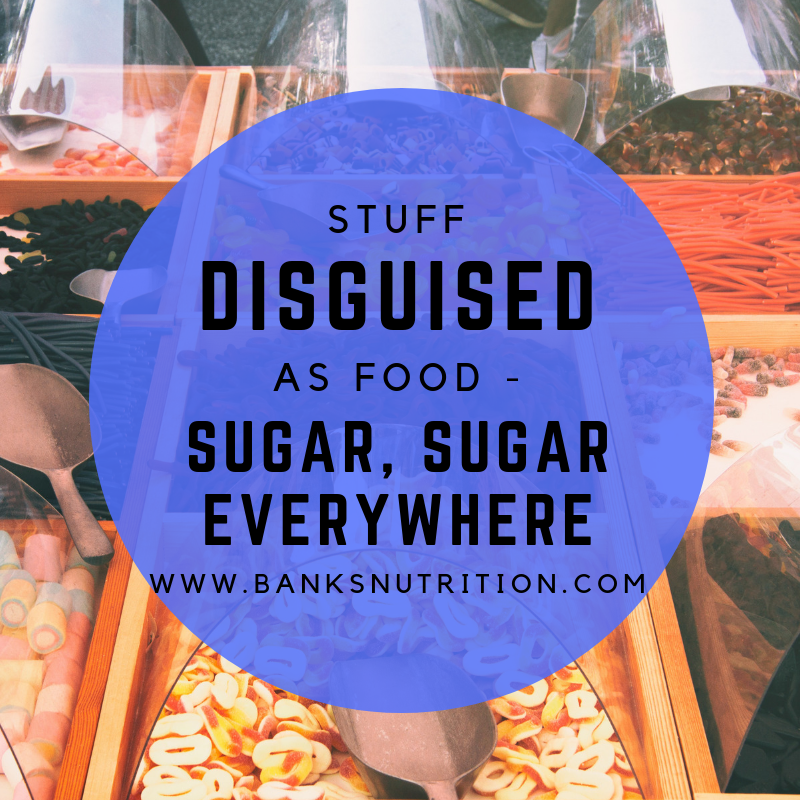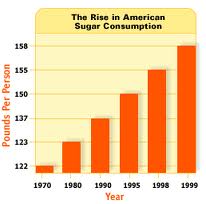
Stuff Disguised as Food – Sugar, Sugar Everywhere
March 3, 2011
-
The consequences of the explosion of sugar in our food are an epidemic of diabetes, metabolic syndrome and obesity.
-
Excess sugars are rapidly converted to a storage fat, triglyceride, by the liver and put back into the circulation destined for fat tissue.
-
When reading food labels, added sugar is often hidden by many different names.
The amount of sugar in the US diet is far in excess of what most people understand and appreciate. A historical perspective is helpful in appreciating this. In the late 1800s the average sugar consumption per person was about 5 lbs per year. One hundred years later it had risen to about 120 lbs per year, or a whopping 2300% increase.
Throughout the last 2 decades the increase has steadily continued with the current estimates putting the yearly consumption at about 180 lbs, or a full pound every 2 days!
The consequences of the explosion of sugar in our food are an epidemic of diabetes, metabolic syndrome and obesity. Almost 1 in 7 adults is now diabetic and another 1 in 5 is prediabetic. One in three children born in 2000 or after will develop diabetes in their lifetime living in our current food environment.
The obesity from sugar consumption surprises some people as they believe, “only dietary fat can cause belly fat”. However, humans only store one form of excess dietary energy or calories; fat. Excess sugars are rapidly converted to a storage fat, triglyceride, by the liver and put back into the circulation destined for fat tissue. When this is happening at high levels, we often make more triglycerides than can be transitioned into fat tissue at any given time and our blood triglycerides become abnormally high.
All of this brings up an important question, why do they put so much sugar in our food? The answer is simple; it stimulates our appetite and drives us to eat more food. This is perhaps advantageous if you sell food, but it is very problematic from a health standpoint.
Humans are wired to be driven to eat in response to the tastes of fat, sugar and salt. These taste drives served man well for most of the first 3 million years of his or her existence when man struggled to get enough to eat and needed to desire energy dense food. It has, however, become a problem over the past 50 to 100 years when we face the availability of plenty of food. The food industry is taking advantage of this evolutionary trait to manipulate excessive food consumption.
To get a grip on the problem, read the label of everything you buy or use for 1 month. First look at the grams of sugar. Most of the inherent (naturally occurring in the carbohydrates) sugar comes from fruits, vegetables and grains. A serving of each should have the following inherent sugar content:

The Nutritional Information box must list the grams of sugar per serving. In a natural grain without added sugars, it should be between 0.5 and 1 gram. Most breads, cereals, muffins, etcetera will have from 8 to 20 grams. This must be added sugar as it exceeds the natural inherent sugar by 8 to 40 times!
Next go to the ingredient list and look for the added sugars. They have many names:
-
Sugar
-
Corn syrup (wet sugar derived from corn)
-
High fructose corn syrup (same as corn syrup but with more fructose)
-
Any “ose” (glucose, fructose, maltose, etc)
-
Cane syrup (wet sugar from sugar cane)
-
Cane sweetener (sugar from cane)
-
Brown rice syrup (wet sugar extracted from rice)
Some of the above terminology seems a little tricky and confusing. That is exactly how it is designed to create the “what you don’t know won’t hurt you” phenomenon.
Sometimes all of this can be seen more in perspective by using the cupcake scale. The single packaged chocolate cupcakes have 18 grams of sugar in them. Is that a good breakfast? The standard cereal bars or granola bars have 14 grams, or 75% of the relative cupcake value yet we think of them as a suitable breakfast. A fruit (actually sugar/fruit syrup) in the bottom yogurt has about 21 grams of sugar, or is 125% of the sugar value of a cupcake. From a sugar perspective, a cupcake is healthier. Tomato soup has 13 grams, or about 70% of the cupcake value.
The average daily sugar intake in the US is equivalent to eating 15 cupcakes per day. The trick is to appreciate that we have 15 cupcakes in our average diet, but they just were different costumes. How they “name” a product does not determine how unhealthy it is, the content does.
The trend towards more corn based sugars is two-fold. Corn is an abundant, inexpensive source of sugar. It also contains more fructose than most other sugar source plants. Fructose is the sweetest of the individual sugars so it drives desire (and therefore consumption) more than any other type of sugar. Once this was realized, the fructose was concentrated even more so in corn syrup to yield high fructose corn syrup.
The whole situation sounds a lot like the drug dealer handing out free samples at the playground. It typically insures it will produce a future customer. The best that each of us can do is to be knowledgeable and manage our own situation. The food industry is the largest and most funded single lobby in Washington so don’t look for the solution to come down from the top.
While humans 50 years of age and younger have always lived in a high sugar food environment, this is new in the broader picture to mankind. We are more than 99% genetically identical to our ancestors of 100,000 years ago, but we are trying to consume a diet that we are ill suited to. The disease statistics speak for themselves about how poorly this is working out. Be informed, read labels intelligently, and fend for yourself!

